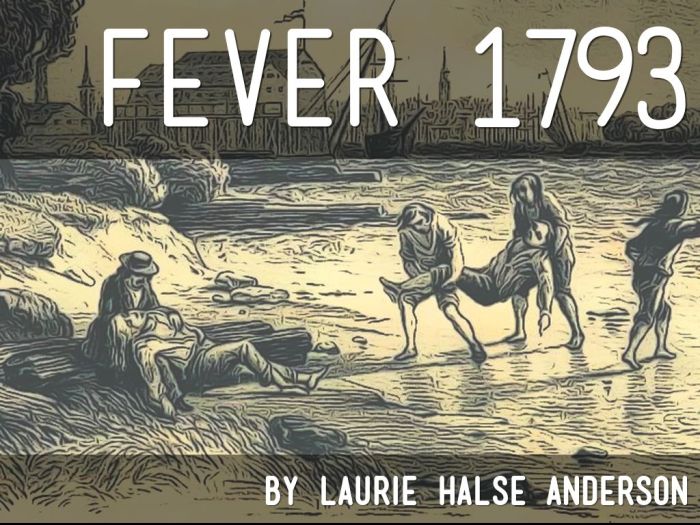Characters in the book fever 1793 – In Laurie Halse Anderson’s Fever 1793, the characters are not mere names on a page; they are complex individuals whose lives and struggles vividly portray the human experience during the devastating yellow fever epidemic in Philadelphia.
These characters grapple with personal and societal challenges, their motivations and relationships shaping the narrative arc as they navigate a world ravaged by disease and social upheaval.
Main Characters

The main characters in “Fever 1793” are:
- Matilda “Mattie” Cook: A 14-year-old girl who lives in Philadelphia during the yellow fever epidemic.
- Eliza Fenwick: A young woman who is a nurse and Mattie’s friend.
- Dr. Benjamin Rush: A famous physician who is trying to find a cure for yellow fever.
- Ned Burwell: A young man who is in love with Mattie.
These characters are all connected to each other in different ways. Mattie and Eliza are friends, and they both know Dr. Rush. Ned is in love with Mattie, and he is also a friend of Dr. Rush.
All of these characters are affected by the yellow fever epidemic, and they all play a role in the story.
Supporting Characters
The supporting characters in “Fever 1793” include:
- Polly Baker: A young girl who is Mattie’s friend.
- Granny Cook: Mattie’s grandmother.
- Mr. Cook: Mattie’s father.
- Mrs. Cook: Mattie’s mother.
These characters all play a role in the story, even though they are not as important as the main characters. Polly is Mattie’s best friend, and she is always there for her. Granny Cook is Mattie’s grandmother, and she is a wise old woman who gives Mattie advice.
Mr. and Mrs. Cook are Mattie’s parents, and they are both loving and supportive.
Historical Context: Characters In The Book Fever 1793
“Fever 1793” is set during the yellow fever epidemic in Philadelphia in 1793. The yellow fever epidemic was a devastating event that killed thousands of people. The epidemic started in the summer of 1793, and it lasted for several months.
The city of Philadelphia was particularly hard hit by the epidemic, and it is estimated that as many as 10% of the city’s population died from the disease.
The yellow fever epidemic had a profound impact on the people of Philadelphia. The epidemic caused widespread fear and panic. People were afraid to leave their homes, and businesses were closed. The city was in a state of chaos.
Social and Cultural Themes

“Fever 1793” explores a number of social and cultural themes, including:
- The role of women in society
- The importance of community
- The power of hope
The book shows how women played a vital role in the fight against the yellow fever epidemic. Eliza Fenwick, a young woman who is a nurse, is one of the main characters in the book. Eliza is a strong and courageous woman who is determined to help others.
She risks her own life to care for the sick, and she is a role model for the other women in the book.
Symbolism and Motifs
“Fever 1793” uses a number of symbols and motifs to convey its themes. One of the most important symbols in the book is the color yellow. Yellow is the color of the yellow fever virus, and it is also the color of hope.
The book shows how the yellow fever epidemic can be both a source of despair and a source of hope.
Another important symbol in the book is the tree of heaven. The tree of heaven is a type of tree that is known for its ability to grow in even the most difficult conditions. The tree of heaven is a symbol of hope and resilience in the book.
FAQ
Who is the protagonist of Fever 1793?
Matilda Cook, a 14-year-old Quaker girl, serves as the protagonist and narrator of the story.
What is the significance of the yellow fever epidemic in the novel?
The yellow fever epidemic provides the backdrop for the story, shaping the characters’ experiences, motivations, and ultimate fates.
How does the novel explore themes of social inequality?
Fever 1793 highlights the stark social and economic disparities of the time, particularly the plight of the poor and marginalized during the epidemic.